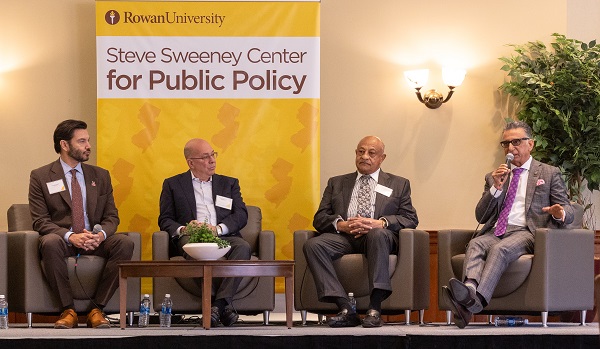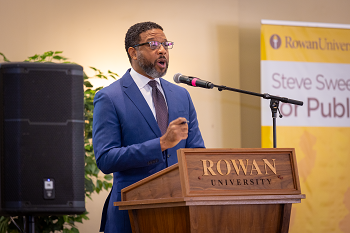Experts explore the legacy of restructuring and the future of higher education at Sweeney Center conference
Experts explore the legacy of restructuring and the future of higher education at Sweeney Center conference

Three decades after a legislative decision transformed New Jersey’s higher education landscape, its outcomes “continue to reverberate to this very day,” according to Brian Bridges, New Jersey Secretary of Higher Education.
Bridges was one of more than a dozen state government representatives and leaders of higher education institutions and organizations to speak at “Restructuring Higher Education in New Jersey: Thirty Years of Change, Future Challenges.” The Steve Sweeney Center for Public Policy and the Rowan University College of Education sponsored the conference held on Oct. 15.
View the full conference on YouTube.
The Higher Education Restructuring Act of 1994 replaced the central authority of the Chancellor and Department of Higher Education with a Council of College Presidents and Secretary of Higher Education. Panelists addressed the legacy of this change and options for future organizational structures that could better support New Jersey colleges.
Reflecting on the impact of higher education restructuring
Prior to the restructuring, the cumbersome old model “stifled institutional innovation,” Bridges said. This change “created more opportunities for innovation and freed up institutional leaders to become more entrepreneurial,” Bridges said.
As he provided historical context on the 1994 decision, George Pruitt, former Thomas Edison State University president and former president of the Council of College Presidents, said that Rowan’s growth “could not have happened under the Board of Higher Education.” Rowan is the third fastest-growing public research institution in the nation, as recognized by The Chronicle of Higher Education.
Still, by taking such an “aggressive approach” to decentralization, Bridges said, “the balance of power shifted away from the state and weakened the capacity for long-term, equitable statewide planning for higher education.”
Over the past 30 years, that shift has resulted in a lack of state support for New Jersey’s higher education ecosystem. According to Pruitt, New Jersey is the only state in the U.S. that provides no capital support for higher education.
 “This affects everyone: students, institutions, the workforce and our economy,” said Bridges (at right). “It's not a problem that we can fix overnight, because it's one that has been decades in the making.”
“This affects everyone: students, institutions, the workforce and our economy,” said Bridges (at right). “It's not a problem that we can fix overnight, because it's one that has been decades in the making.”
Speakers discussed the many challenges that higher education institutions are facing today, including declining enrollment, increased competition for a shrinking pool of traditional students and shifts in the student population.
Senator Joseph Cryan, who chairs the Senate Higher Education Committee, called this a “transformational time in higher education.
“We need to develop a common-sense, cohesive, well debated and thought-out process where higher education is going in the next 30 years,” Cryan said.
Numerous speakers touched upon the issue of New Jersey students leaving for out-of-state colleges.
“When we lose those students that cost us about $250,000 to educate in K-12 to another state, they won't come back,” said Jennifer Keyes-Maloney, executive director for the New Jersey Association of State Colleges & Universities. “If we really want to invest in an innovative economy, we need to, in essence, make sure those students stay here and grow a family here.”
Frederick Keating, president of Rowan College of South Jersey, envisions integrated pathways between high schools, community colleges and four-year institutions as a way to fix the “disjointed” system.
“The education system in the state of New Jersey is not structurally aligned. It’s cobbled together,” Keating said. By building a bridge from high school to county college, institutions can give students a taste of higher education—and a clear pathway to continue it, he noted.
Balancing investment with the freedom to innovate
The structural organization of the state’s higher education system will determine how institutions address the higher education challenges of the future. Bridges aims to develop a model that facilitates autonomous innovation, coordination and accountability for state investments.
Panelists discussed options ranging from increased coordination between institutions to a single educational system encompassing kindergarten through college. Experts agreed that the question of how to reshape the future of higher education was nuanced, and the answers had to be, too.
“You need to have institutions enjoy the latitude to be creative, to be nimble, to be flexible, to innovate,” said Jonathan Koppell, president of Montclair State University.
Perhaps the biggest takeaway from the discussion was the necessity of changing the structure of the higher education ecosystem.
“I really do believe that the status quo is not tenable,” said Ali Houshmand, president of Rowan University.
Michael Avaltroni, president of Fairleigh Dickinson University, agreed.
“The business model of higher education is fundamentally broken,” Avaltroni said. “Until we acknowledge this, we can't begin to think about creative ways to solve that problem and rescue ourselves from what I see as an unsustainable future for our industry.”
Calling higher education a “public good,” Bridges highlighted what’s at stake.
“Higher education doesn't just improve the lives of individuals,” Bridges said. “We must ensure its governance is effective, efficient and balanced. The future social and economic well-being of individuals, communities and the state of New Jersey is relying on that.”